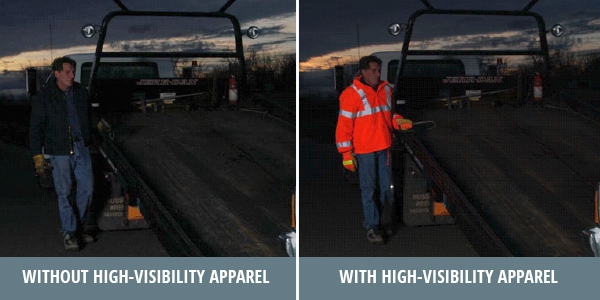Enhanced and High-Visibility Garments
![]() Print this Article | Send to Colleague
Print this Article | Send to Colleague

Worker visibility is critical to worker safety. Workers must be visible in all lighting conditions and against complex environmental backgrounds. Have you ever wondered what the difference is between Enhanced and High-Visibility? Here’s a quick reference that outlines the distinction...
Enhanced Visibility
Enhanced-visibility garments are reflective uniforms with added retroreflective trim. There are no minimum reflective-material requirements and testing is not required. Enhanced-visibility garments are intended for workers who seek to improve their visibility in low-light conditions.
High-Visibility (ANSI-Compliant)
High-visibility garments comply with the ANSI-107 consensus standard. ("ANSI" stands for the American National Standard Institute.) The ANSI-107 standard addresses worker visibility and specifies minimum amounts of background and retroreflective trim. Typically, a high-visibility garment is constructed of fluorescent yellow or fluorescent orange fabric that is 100% polyester (there are some exceptions for flame-resistant garments).
There are five classes of protection:
• Class 1: "Performance Class 1 provides the minimum amount of required material to differentiate the wearer from the work environment."¹ Examples of garments in this class are vests, jackets, or shirts with a minimum amount of retroreflective and/or fluorescent background material.
• Class 2: "Performance Class 2 provides superior visibility for wearers by the additional coverage of the torso and is more conspicuous than Performance Class 1."2 Examples of garments in this class are vests, shirts, jackets, and coveralls that meet the minimum specified requirements of retroreflective and background material for Performance Class 2.
• Class 3: "Performance Class 3 provides greater visibility to the wearer in both complex backgrounds and through a full range of body movements. Regardless of the area of materials used, a sleeveless garment or vest alone shall not be considered Performance Class 3."3 Examples of garments in this class are vests, shirts, jackets, and coveralls that meet the minimum specified requirements of retroreflective and background material for Performance Class 3.
• Class E: "Waistband trousers, bib overalls, and shorts that meet all minimum requirements for retroreflective and background materials, except for minimum area and placement required for Performance Class 3, 2, or 1 shall be designated Class E. Class E apparel is not intended to be worn without Performance Class 2 or 3 apparel. When Class E trousers are worn with Performance Class 2 or Class 3 apparel, the overall classification for the ensemble shall be Performance Class 3." 4
• Headwear: "Headwear is considered an important accessory and complements the overall visibility of the wearer. High-visibility headwear enhances visibility to the head of a moving worker in daylight and helps define the shape of the human form during nighttime exposure."5
1-5 Excerpted from the ANSI/ISEA 107-2010 "American National Standard for High-Visibility Safety Apparel and Headwear" (section 5.1)
High-Visibility Flame Resistant Garments
• Enhanced visibility Flame Resistant garments provide protection in electric arc flash, flash fire, molten metal, or combustible dust environments while being more visible in limited light conditions, offering added protection and safety for your workforce.*
To learn more about how visibility garments can improve the safety of your employees, please reach out to your designated CIOMA contact Rob Faulkenberry, Senior National Account Executive, rfaulken@gkservices.com, phone: 303-591-4102
*A workplace hazard assessment will help determine your protection needs and what fabrics may meet the safety requirements. Not all FR fabrics may not be suitable for all applications. Customers of G&K Services are solely responsible for selecting appropriate garments and protective gear for their employees and ensuring wearers use the garments and protective gear properly and in conjunction with appropriate gloves and footwear. Because working conditions and other factors may vary, G&K Services does not make any representation that these garments and protective gear will protect wearers from injury.
